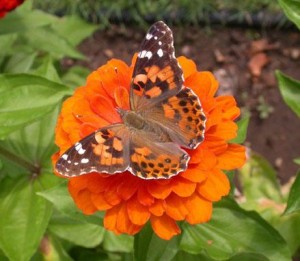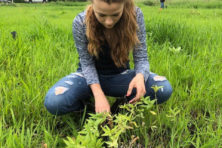The beauty of butterflies
- Share
- Tweet
- Pin
- Share
Few creatures are as gentle, harmless, common and beautiful as butterflies. They don’t chase after you, bite or sting you, and they cannot transmit diseases. An ideal sunny summer day has me sitting outdoors, lazy and idle, and suddenly experiencing a butterfly flutter by.
One can look at butterflies as winged flowers, gems in flight, radiant wings with golden freckles, quietly flying, fluttering, frolicking, and basking in the sunshine, the perfect examples of peacefulness and tranquility. I know of a “secret” road and adjoining fields that could very well be called Butterfly Vale, the perfect place to enjoy life beneath a summer sky. The most productive butterfly morning in July, 20 or more years ago, had my young students of the butterfly workshop at the Ridges, each armed with a butterfly net, catching, enjoying from inches away, and then releasing 19 different species of butterflies at Butterfly Vale.
Indeed butterflies are insects of sunny days. They would be good examples of “sun worshippers” in that you seldom see them on overcast days. It is almost as though the sun provides them with the power of flight. It is also uncommon to see a butterfly on the wing with the temperature below 50 degrees F.
Dave Tylka said in his fine Missouri Dept. of Conservation booklet, “Butterfly Gardening and Conservation,” that “Butterflies go wherever they please and please wherever they go.” Yet they have the uncanny ability to locate very specific host plants upon which to lay their eggs. People who specialize in the study of butterflies, and moths too, are usually very good botanists.
Approximately 138 species of butterflies have been collected in Wisconsin. Not all are permanent residents here, a few having strayed into the state. Others, existing in collections today, may have been inhabitants of this state years ago but, due to various changes brought about mostly by people, have disappeared from Wisconsin.
Door County, as an example, should produce during an average summer between 40 and 50 species of butterflies. Some, like the Dorcas Copper or Compton’s Tortoise-shell, are very rare while others, including the Monarch, Mourning Cloak and White Admiral, are quite common.
Butterflies, or general groups of them, that we expect to see from April through late fall include the Red Admiral, Painted Lady, the Fritillaries, Wood Nymphs and Satyrs, Angle-wings, Tortoise-shells, Skippers, Blues, Hairstreaks, Sulfurs, Pearl Crescent, Harvester, Coppers, White Admiral, Mustard White, Swallowtails, Monarch and Viceroy.
Butterflies capable of surviving our winters as adults, within an outdoor woodpile or behind a loose piece of tree bark, for example, have always amazed me. These primarily include the Painted Lady, the Comma, Milbert’s Tortoise-shell and Mourning Cloak. How thrilled we are, occasionally during the spring period of maple syrup making in area sugar bushes, to see a Mourning Cloak winging its way through the woods on a sunny day when in a few places snow still lingers in the woods.
One of the very earliest butterflies on the wing, usually on warm sunny days in early May, is the tiny Spring Azure, one of our favorites. They do not overwinter as adults but rather in their chrysalis state. The eclosion of the adult from its chrysalis is perhaps the earliest of any butterfly in our region. The only time you see its flashy azure-blue upper wing surfaces is when it’s in flight, usually quite close to the ground. Upon landing it invariably folds its wings quickly together showing the dirty gray-blue undersides containing small dark spots forming bands.
During my many years of teaching young people in the classroom and also at the Ridges Sanctuary I became thoroughly convinced that cultivating in children admiration and respect for butterflies and other small creatures helps these young people become more sensitive adults, aware of and concerned for the world around them. Could you imagine the requirements for high school graduation including the recognition of 25 species of butterflies, their caterpillars and host plants? I can! After all, these young adults will someday be responsible for leadership and for caring for their environment. They might as well know something about it. Why not begin at the bottom for a change and learn the basics such as the birds, trees, wildflowers, ferns and butterflies that exist in their county or in their own backyard?
How healthy is your natural community? Are there many species of butterflies there? These fragile insects can serve as a national or even global barometer of a clean environment. At times I wish that every form of wildlife could somehow be monitored. Very few people show more than a passing interest in butterflies. One of the few nation-wide annual butterfly surveys, unfortunately conducted on a relatively small scale, is the Annual 4th of July Butterfly Count undertaken by interested members of the North American Butterfly Association (www.naba.org).
I encourage you to invest in a good butterfly field guide. My top choice is: Butterflies of the North Woods, (2nd edition), by Larry Weber. This is an excellent reference in every respect. Another suggestion that will help you get close looks at the butterflies, which in turn will greatly help in their proper identification, is a pair of close-focusing binoculars. Good ones to consider include: Bausch & Lomb 8×42 WP Elite, Bushnell 8×42 Legend, Eagle 8×42 Ranger Platinum, and Nikon 8×42 Monarch. We use the latter, which focuses to eight feet. Others may focus closer. As to my first choice for a source for purchasing binoculars, and receiving excellent help, consider Eagle Optics in the Madison area (www.eagleoptics.com).
Numerous facets of our life-styles are becoming very arbitrary and irrelevant. Many of us would be much better off if we slowed down, lived more simply, and studied butterflies every summer! Develop this into a life-long hobby. And remember, butterflies are light and delicate but are powerful reminders of how fragile our planet Earth is!




